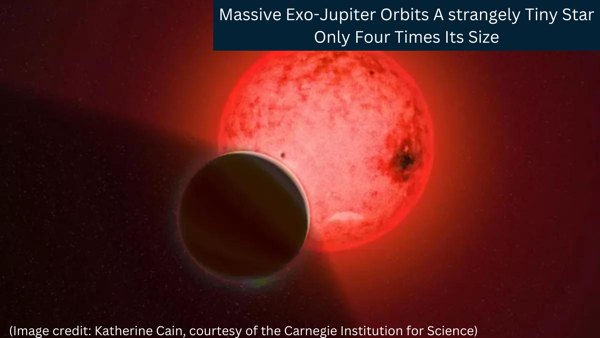
Science & Space
Exoplanet Alert: Massive "Exo-Jupiter" Orbits A Bizarrely Small Star Only Four Times Its Size
There are billions of trillions of planets revolving around their star without being detected by the human-made ground base and space base telescopes, but this time humans have discovered a very unusual exo-Jupiter orbiting a star only four times its size.
This discovery of an exo-Jupiter calls into question the formation of gas giants around any star because this star is tiny in comparison to its planet; either the exoplanet was part of a binary system or this exoplanet is a failed star that failed to evolve as a star; another logic is that this was a stray planet that was captured by the star's gravity and has remained there since.
Another reason for the formation of this star could be that the exoplanet was formed from the dust of its host star that accumulated around it over millions of years.
The exo-Jupiter orbits a red dwarf star, TOI-5205, which is extremely tiny. The star is only four times the radius of its planet, and its mass and radius are less than 40% of that of our sun. Therefore, its surface temperature is quite low in comparison to the sun, as a result of that, the star is also much cooler.
These M-dwarf stars, the most common type of stellar body in the Milky Way, are redder than the sun due to their small size and relatively cool temperatures.
The discovery of this exo-Jupiter has been designated as TOI-5205b by astronomers using NASA's Transiting Exoplanet Survey Satellite (TESS) telescope. The team used various ground-based telescopes and instruments to confirm and define the character of the gas giant. Still, there is much to discover about the exo-Jupiter and its host star.
The astronomer used the transit method to discover the planet. Though gas giants have been discovered orbiting M dwarf stars in the past, none have orbited such a low mass example of this class of star-like TOI-5205. This event is very unique for astronomers and scientists.
In general, red dwarfs host a number of exoplanets, and red dwarfs are widely available and scanned by scientists and astronomers in order to locate plants in the goldilocks zone of stars.
TOI-5205b has one of the highest mass ratios for M dwarf planets, with a mass ratio of nearly 0.3%, as it orbits a host star with a sol mass of only 0.3920.015. It has a planetary radius of 1.030.03 RJ and a mass of 1.080.06 MJ. Furthermore, due to the planet's large size orbiting a small star, the transit depth is 7%, making it one of the deepest transits of a confirmed exoplanet orbiting a main-sequence star. Moreover, TOI-5205b's orbit is uncomfortably close, traveling around the red dwarf once every 1.6 days.
TOI-5205b's large transit depth makes it an appealing target for probing its atmospheric properties and tracing potential formation pathways. TOI-5205b's mass defies conventional theories of planet formation and disc scaling relations, which are incapable of reproducing the conditions required to form such planets.
According to current planet formation models, it takes 10 times the mass of Earth to create a gas giant. This first forms a rocky core, which then accumulates gas to form the disc that will eventually grow into a giant planet.
Planets form in spinning discs of gas and dust known as "protoplanetary discs" that orbit young stars. This substance is the remnants of the same matter that collapsed to give birth to the central star. This planet's core is also made of collected remnants of the central star, and it may have a large solid core due to its shape being so close to its star.
This star and its exo-Jupiter is a mystery for scientists and it will remain a mystery until the solution of its existence won't be solved. Its host star is also a mystery because these stars lose their power slowly, they will last trillions of years, far longer than the current age of the universe, which is 13.8 billion years old. This is the mystery that must be solved because how will this survive trillions of years if no universe remains?
Therefore, Scientists and astronomers are eager to examine the mysterious exo-Jupiter with the most powerful James Webb space telescope.

0 Comments